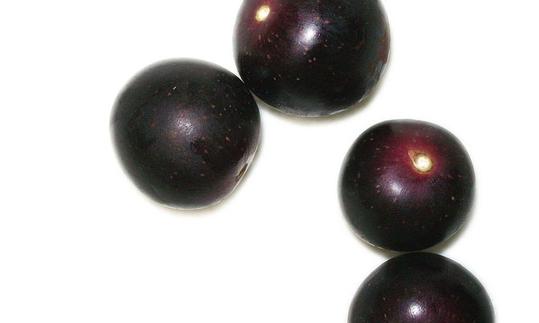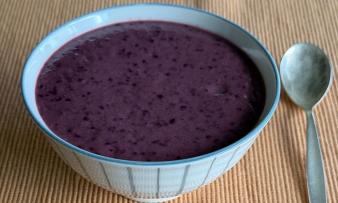Table of contents
Muscadine grapes ( Muscadinia rotundifolia Simpson ex Munson) grow primarily in the southeastern United States and Mexico.
Use in the kitchen
Muscadine is a round grape variety with a diameter of between 0.5 cm and 4.0 cm. The skin is very thick and, depending on the variety, black-violet, bronze or light green. The flesh is sweet, with a bitter-spicy taste and a musky aroma. It is used both as a table grape and for making grape juice, red wine and white wine. It should not be confused with the noble grape vine ( Vitis vinifera subsp. vinifera), which is the most popular grape variety in the world.
In American cuisine, muscadine grapes are traditionally used to make jelly, jam, fruit cakes and pies. Raw muscadine grapes are a popular fresh fruit. Because of the thick skin, they are sometimes peeled before eating. This is a shame, however, because most of the nutrients are contained in the skin. The table grapes go wonderfully in a fruit salad together with watermelon, banana and apple. They can also be used as a topping for pea muesli or a smoothie bowl.
The sweet grapes also taste delicious in raw salads, for example with fennel, carrot and lamb's lettuce, in an oil-free salad dressing. Muscadine is rarely used to make raisins (dried grapes).
Vegan recipe for muscadine grape jam
Ingredients (for 4 servings): 1 kg muscadine grapes, 200 ml red table wine, 200 ml apple juice, 2 tsp agar-agar (or as needed).
Preparation: Wash the grapes thoroughly and then separate the grape skins from the pulp. Puree the grape skins well in a blender. Bring the pulp to the boil in a pan with the red wine and apple juice and then simmer for 15 minutes. Pass the fruit mixture through a sieve over a large bowl. Pour the collected thick juice back into a clean pan and leave to cool. Add the pureed grape skins and mix the entire mixture with agar-agar. Bring to the boil and simmer for approx. 2 minutes (or according to the manufacturer's instructions). Carry out a gelling test. If it is still too liquid, simmer a little longer. Then fill the jam into prepared screw-top jars. Leave to cool, tightly closed.
Separating the grape skin and pulp is more time-consuming than boiling the grapes whole and then passing them through a sieve. However, most of the grape's ingredients are in the fruit skin and the seeds. Because the pureed grape skin is used whole, the jam has a higher nutrient content. If you don't want to use wine (alcohol), you can replace it with water or use twice the amount of apple juice. The apple flavor goes well with the grapes. If you use green muscadine grapes (Scuppernong), you should use white table wine.
| Not only vegans or vegetarians should read this: Vegans often eat unhealthily. Avoidable nutritional mistakes. |
Purchasing - Storage
Since Muscadine grapes cannot be grown in Europe, they are not available in the range of major retailers such as Coop, Migros, Denner, Volg, Spar, Aldi, Lidl, Rewe, Edeka, Hofer, and Billa (as of 2023). Organic supermarkets such as Denn's Biomarkt and Alnatura also do not stock the grape variety. The availability of fresh grapes in the United States and Mexico is from August to October. 4
Storage tips
Ripe muscadine grapes can be stored in the refrigerator for one to two weeks. 4
Ingredients - Nutritional values - Calories
Muscadine grapes (raw) contain 57 kcal per 100 g. They contain little fat (0.47 g/100g) and protein (0.81 g/100g). The carbohydrate content is 14 g, of which 8.2 g is sugar. Due to the thick fruit skin, muscadine grapes contain a lot of fiber (3.9 g/100g). 1
With 1.5 mg per 100 g, muscadine grapes contain a lot ofriboflavin (vitamin B2). This corresponds to 107% of the daily requirement. This is an unusually high amount for a fruit or berry. In comparison, passion fruit contains only 0.13 mg, aronia berries only 0.10 mg, andblueberries andraspberries only 0.04 mg. Good sources of riboflavin are mainly nuts, herbs, mushrooms and legumes. 1
Muscadine grapes also contain a lot of manganese, at 2.0 mg/100g. This corresponds to 99% of the daily requirement. Aronia berries (1.7 mg/100g) and fresh coconut meat (1.5 mg/100g) have a similar value. They also contain small amounts of copper, potassium and vitamin C. 1
The grape variety Vitis vinifera (noble grape) has more sugar and less fiber than the Muscadine grape. The nutrient composition is very different. It contains mainly vitamin K, copper and potassium and almost no riboflavin. 1
The complete ingredients of Muscadine grapes, the coverage of the daily requirement and comparison values with other ingredients can be found in our nutrient tables. In the article Nutrients explained you will get a detailed insight into the topic.
Effects on health
Muscadine grapes and wine contain anthocyanins, flavonoids and ellagic acid, as well as polyphenols such as resveratrol and quercetin. The seeds, peel and pulp have different nutrient compositions. Anthocyanins and polyphenols (including resveratrol) are mainly found in the fruit peel. 16
Numerous in vitro studies have shown that polyphenols have an anti-cancer effect. It has been proven that polyphenols from muscadine grapes inhibit the growth of cancer cells or cause them to destroy themselves (apoptosis). 14,15
Muscadine grapes have a high antioxidant content. Studies with dried and powdered fruit skin showed that it had an anti-inflammatory effect, both in vitro and in vivo in a mouse model. The results suggest that the effect could also be detected in inflammatory processes in the human body. However, studies on this are lacking so far. 10 In a mouse model, researchers were able to demonstrate that the fed polyphenols from muscadine grapes and wine also had a soothing effect on inflammation that leads to rheumatoid arthritis. The inflammation occurred more slowly and was less severe. The researchers therefore see polyphenols as a promising dietary approach for the prevention and treatment of arthritis in humans. 11
With the emergence of more and more resistant bacteria, interest in alternative antibacterial agents is high. Studies show that polyphenol extracts from muscadine grapes have an antibacterial effect against E. coli bacteria, listeria, salmonella and staphylococci (Staphylococcus aureus), among others. Possible applications could be in the food industry as well as in the medical field. 13
Obese mice that were fed additional phytochemicals extracted from muscadine grapes for 15 weeks had reduced levels of free fatty acids, triglycerides and cholesterol. Compared to mice that were fed only a high-fat diet, the body weight of mice fed the high-fat diet and extracts decreased by 12%. The researchers conclude that muscadine extracts could help reduce the negative consequences of obesity. 12
Dangers - Intolerances - Side effects
Allergic reactions to real grapes ( Vitis vinifera subsp. vinifera) are rare, but can be serious in some individuals. 9 There are currently no studies on allergic reactions caused by muscadine grapes (as of 2023).
Muscadine grapes contain fructose, so people with fructose intolerance should avoid them.
Ecological footprint - animal welfare
The ecological CO 2 footprint of grapes depends on the country of origin, the cultivation method and of course the packaging and sale. Unfortunately, there is no specific data on the amount of emissions generated during production for individual varieties (such as muscadine grapes). On average, 0.4 kg CO 2 eq is generated per kilogram of grapes produced. 18 The amount of water required to produce 1 kg of grapes is 608 liters of water, which is significantly less than apples (822 liters) or pears (922 liters). 19
Unlike other grape varieties, American muscadine grapes are relatively drought-resistant, so irrigation is kept to a minimum. 7 Muscadine grapes provide food for songbirds, grouse, wild turkeys, small mammals, squirrels, deer, raccoons, foxes and black bears. The vines provide nesting cover for songbirds. Bees and other pollinators enjoy the nectar of the flowers. 4
The muscadine grapevine has protective mechanisms against a number of diseases, insects and nematodes that the common grapevine Vitis vinifera lacks. It is particularly resistant to mildew and downy mildew, as well as to Pierce's disease and phylloxera. 3,4,17 For this reason , Vitis rotundifolia is sometimes used as a rootstock for noble grapevines of the Vitis vinifera variety. 17 Due to its high natural resistance to pests, pesticides are not used as often in the cultivation of the muscadine grape, which is better for the environment.
Worldwide distribution - cultivation
The muscadine grape is a native grape variety that was grown in North America before the introduction of the grapevine. Cultivation has been documented for at least 400 years. 7 The natural distribution area of the muscadine grape extends from Delaware to central Florida and is found in all states along the Gulf Coast to East Texas. It also extends north along the Mississippi River to Missouri. It can also be found in parts of northern Mexico. 2,5 It grows wild in dry upland forests near swamps, roadsides and on forest edges. 4
The first breeding programs have been known for 100 years and have resulted in numerous varieties. 7 Muscadine grapes are mainly grown for home use. They are sometimes grown semi-commercially for local sales. The area cultivated for wine production is also small. The sales market is still small, but could grow in the coming years. 3,6,7
Cultivation - Harvest
Muscadine grapes prefer dry, sandy to stony soils. 4 It is important that the soil is permeable to water and that the location is sunny. 7 The vines prefer warm, humid weather and winters that are no colder than -12 to -15 °C. 6
Muscadine grapes are dioecious, meaning there are male and female flowers. 4 In addition to varieties that only have female flowers and therefore need a male individual for cross-pollination, there are also varieties with male and female flowers on the same plant. 7 The vines need a framework to grow on. If you prune the plants correctly and regularly, you can increase the yield. Irrigation is recommended in the first two years during periods of drought; after that, the muscadine tolerates drought well and can draw the water it needs from the soil. 7 The grapes grow individually and loosely. The harvest time depends on the growing area and is between August and October. 4
Further information
Muscadine grapes ( Vitis rotundifolia Michx., syn. Muscadinia rotundifolia Simpson ex Munson) belong to the grapevine family (Vitaceae). The grapevine genus ( Vitis) has two subgenera: Euvitis, to which the noble grapevine ( Vitis vinifera subsp. vinifera) belongs, and Muscadinia, to which the muscadine grape belongs. The subgenus Muscadinia includes two other varieties , Vitis munsoniana (mainly in Florida) and Vitis popenoei (Mexico and Central America). 2
The Muscadina has 40 chromosomes, as opposed to the 38 chromosomes of all other Vitis species. This is why most hybrid vines made from Muscadinia and Euvitis vines are sterile. 2 A commercial, fertile Euvitis × Muscadinia hybrid is the variety "Southern Home". 8
Muscadine grapes should not be confused with Muscat grapes, which are a grape variety of the noble grape vine ( Vitis vinifera subsp. vinifera).
Alternative names
The American grape variety has several common names such as Bird Grape, Bullace Grape, Bullit Grape, Currant Grape, Muscadine Grape, Roanoke, Southern Fox Grape and Vigne Musquée and for the bronze-green varieties often Scuppernong. The English name is muscadine grape. In Spanish it is called uvas muscadina. Incorrect spellings are Mukadine, Muscadinr, Muscafine, Muscadie, Muscdine.
Bibliography - 19 Sources (Link to the evidence)
| 1. | USDA United States Department of Agriculture. |
| 2. | Buck K, Worthington M. Genetic Diversity of Wild and Cultivated Muscadine Grapes (Vitis rotundifolia Michx.). Front Plant Sci. 2022 Mar 28;13: 852130. |
| 3. | Stanley D. America's First Grape: The Muscadine. USDA Agriculture Research Magazine 1997 Nov; 45(11): 14-16. |
| 4. | NC State University. North Carolina Plant Toolbox. Vitis rotundifolia. |
| 5. | UF IFAS University of Florida. The Muscadine Grape (Vitis rotundifolia Michx.). |
| 6. | Texas A&M University. Fruit & Nut Resources. Muscadine. |
| 7. | NC State University. Muscadine Grapes in the Home Garden. |
| 8. | Mortensen JA, Harris JW, Hopkins DL, Andersen PC. Southern Home: An Interspecific Hybrid Grape with Ornamental Value. Hort Science;29(11): 1371–1372. |
| 9. | Vassilopoulou E, Zuidmeer L, Akkerdaas J, Tassios I, Rigby NR, Mills EN, van Ree R, Saxoni-Papageorgiou P, Papadopoulos NG. Severe immediate allergic reactions to grapes: part of a lipid transfer protein-associated clinical syndrome. Int Arch Allergy Immunol. 2007;143(2): 92-102. |
| 10. | Greenspan P, Bauer JD, Pollock SH, Gangemi JD, Mayer EP, Ghaffar A, Hargrove JL, Hartle DK. Antiinflammatory properties of the muscadine grape (Vitis rotundifolia). J Agric Food Chem. 2005 Nov 2;53(22): 8481-4. |
| 11. | Christman LM, Wang GP, Washington TL, Gu L. Muscadine grape (vitis rotundifolia) and wine polyphenols alleviated arthritis and restored the gut microbial composition in mice. J Nutr Biochem. 2023 Jun;116: 109311. |
| 12. | Gourineni V, Shay NF, Chung S, Sandhu AK, Gu L. Muscadine grape (Vitis rotundifolia) and wine phytochemicals prevented obesity-associated metabolic complications in C57BL/6J mice. J Agric Food Chem. 2012 Aug 8;60(31): 7674-81. |
| 13. | Xu C, Yagiz Y, Hsu WY, Simonne A, Lu J, Marshall MR. Antioxidant, antibacterial, and antibiofilm properties of polyphenols from muscadine grape (Vitis rotundifolia Michx.) pomace against selected foodborne pathogens. J Agric Food Chem. 2014 Jul 16;62(28): 6640-9. |
| 14. | Hudson, T. S.; Hartle, D. K.; Hursting, S. D.; Nunez, N. P.; Wang, T. T.; Young, H. A.; Arany, P.; Green, J. E. Inhibition of prostate cancer growth by muscadine grape skin extract and resveratrol through distinct mechanisms. Cancer Res. 2007, 67, 8396−8405. |
| 15. | Mertens-Talcott SU, Lee JH, Percival SS, Talcott ST. Induction of cell death in Caco-2 human colon carcinoma cells by ellagic acid rich fractions from muscadine grapes (Vitis rotundifolia). J Agric Food Chem. 2006 Jul 26;54(15):5336-43. |
| 16. | Xu C, Yagiz Y, Zhao L, Simonne A, Lu J, Marshall MR. Fruit quality, nutraceutical and antimicrobial properties of 58 muscadine grape varieties (Vitis rotundifolia Michx.) grown in United States. Food Chem. 2017 Jan 15;215: 149-56. |
| 17. | Heinitz CC et al. Crop Wild Relatives of Grape (Vitis vinifera L.) Throughout North America. In: Greene S, Williams K, Khoury C, Kantar M, Marek L (eds) North American Crop Wild Relatives, Volume 2. Cham: Springer; 2019: 329–351. |
| 18. | Reinhardt G, Gärtner S, Wagner T. Ökologische Fussabdrücke von Lebensmitteln und Gerichten in Deutschland. Institut für Energie - und Umweltforschung Heidelberg. 2020. |
| 19. | Mekonnen MM, Hoekstra AY. The green, blue and grey water footprint of crops and derived crop products. Hydrol. Earth Syst. Sci. 2011; 15: 1577-1600. |









Comments